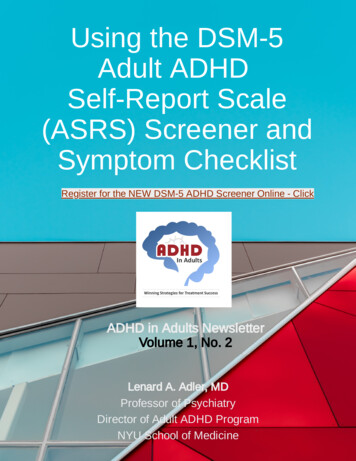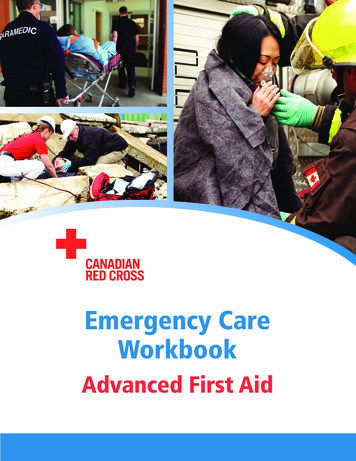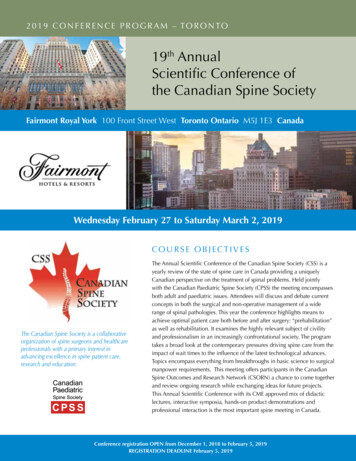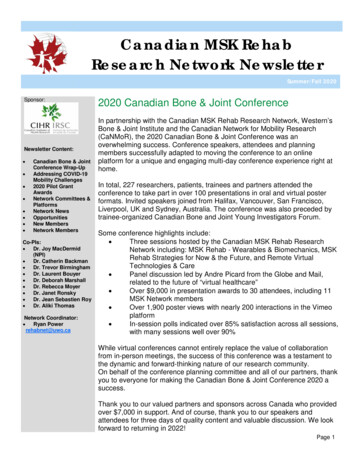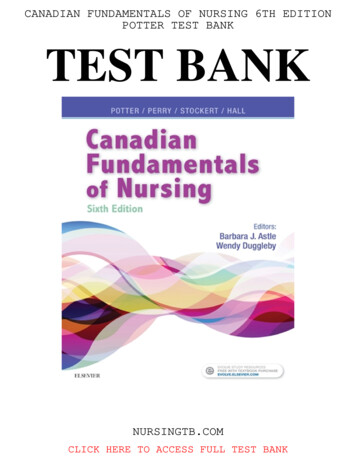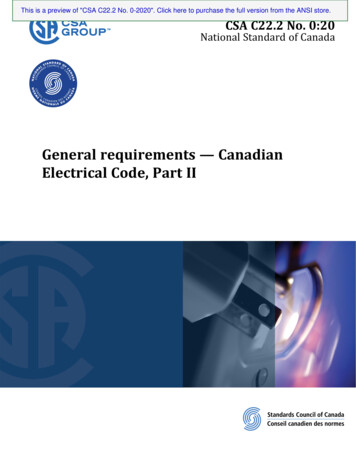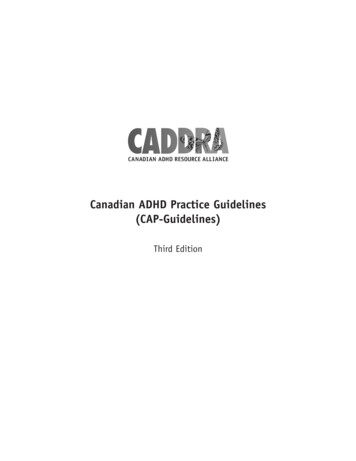
Transcription
Canadian ADHD Practice Guidelines(CAP-Guidelines)Third Edition
Copyright Notice and Permitted Uses of the Guidelines.No material available at www.caddra.ca (the "Materials") may be copied, reproduced, republished, uploaded,posted, transmitted, or distributed in any way, except that you may:(a) Download one copy of the Materials on any single computer for your personal or medical practice useonly, provided you keep intact all copyright and other proprietary notices. Where stipulated, specific “toolsand patient handouts”, developed for physicians and other medical professionals to use in their practice, maybe reproduced by medical professionals or on the advice of medical professionals;(b) Give a presentation using the Materials, so long as: (i) the purpose of the presentation or distributionis for public education; (ii) you keep intact all copyright and other proprietary notices in the Materials; and(iii) the presentation or distribution is completely non-commercial and you or your organization receive nomonetary compensation. If monetary compensation is involved you must provide notice to CADDRA at leastten (10) business days before the presentation and request permission.Modification of the Materials or use of the Materials for any other purpose, without the prior writtenconsent of CADDRA, is a violation of CADDRA's copyright and other proprietary rights.CADDRA InformationCurrent contact details for the Canadian ADHD Resource Alliance (CADDRA) and information on orderingcopies of the Canadian ADHD Practice Guidelines are available on the CADDRA website: www.caddra.caGuidelines CitationThe correct citation for this document is: Canadian Attention Deficit Hyperactivity Disorder Resource Alliance(CADDRA): Canadian ADHD Practice Guidelines, Third Edition, Toronto ON; CADDRA, 2011.French EditionThis document is also available in French under the title: Lignes directrices canadiennes pour le TDAH,troisième édition, 2011.FeedbackReader suggestions can be provided through a feedback form on our website (www.caddra.ca) or emailfeedback@caddra.caLiabilityWhile great effort has been taken to assure the accuracy of the information, the CAP-Guidelines Committee,CADDRA and its members, designer, printer and others contributing to the preparation of his documentcannot accept liability for errors, omissions or any consequences arising from the use of the information.Since this document is not intended to replace other prescribing information, physicians are urged to consultthe manufacturers' and other available drug information literature before prescribing.Please Note:The CADDRA Canadian ADHD Practice Guidelines (CAP-G) is an active document that will be revised online asnew information becomes available. The CADDRA website (www.caddra.ca) will always have the latest versionof the Guidelines available free to download and print. This third edition is in binder format to facilitate thereplacement of pages with updated versions. Updated documents will be sent out to CADDRA members atperiodic intervals. Extra support documents are also accessible to members online.ISBN: 978-0-9738168-2-2 2010 Canadian Attention Deficit Hyperactivity Disorder Resource Alliance (CADDRA)
TABLE OF CONTENTSCAP-G Committee Disclosures . iiCAP-G Committee & Editorial Consultants . iiiPreface and Acknowledgement . ivCADDRA Principles . viChapter 1: Diagnosis and Overview of Visits .1.1Chapter 2: Differential Diagnosis and Comorbid Disorders .2.1Chapter 3: Specific Issues in Management of ADHD in Children . 3.1Chapter 4: S pecific Issues in Management of ADHD in Adolescents . 4.1Chapter 5: Specific Issues in Management of ADHD in Adults . 5.1Chapter 6: Psychosocial Interventions and Treatments . 6.1Supporting DocumentsA: School Letters . 6.7B: Cognitive Behaviour Therapy . 6.9C: Driving Risk . 6.11Chapter 7: Pharmacological Treatment of ADHD . 7.1Supporting DocumentsCanadian Medication Chart (in binder front pocket)A: Medication Tables per Age Group . 7.9B: Specific Information on Medications . 7.15C: Side Effects Management . 7.20D: Cardiovascular Risks . 7.23E: Additional Medication Information . 7.26CHILD/ADOLESCENT TOOLKITADULT TOOLKITAssessment and Follow-Up FormsAssessment and Follow-Up FormsCADDRA ADHD Assessment Form8.1CADDRA ADHD Assessment Form8.1Weiss Symptom Record (WSR)8.14Weiss Symptom Record (WSR)8.14ADHD Checklist8.20ADHD Checklist8.20SNAP-IV-268.22Adult ADHD Self-Report Sale (ASRS)8.24Weiss Functional Impairment Rating Scale –Parent Report (WFIRS-P)8.29Weiss Functional Impairment Rating Scale –Self Report (WFIRS-S)8.26CADDRA Teacher Assessment Form8.31Weiss Functional Impairment Rating Scale –Parent Report (WFIRS-P)8.29CADDRA Clinician ADHD Baseline/Follow-Up Form8.34CADDRA Clinician ADHD Baseline/Follow-Up Form8.34CADDRA Patient ADHD Medication Form8.35CADDRA Patient ADHD Medication Form8.39HandoutsHandoutsCADDRA ADHD Information and Resources8.39CADDRA ADHD Information and Resources8.39CADDRA Child Assessment Instructions8.43CADDRA Adult Assessment Instructions8.46CADDRA Adolescent Assessment Instructions8.44CADDRA Teachers Instructions8.45References . 9.1Index . 10.1Prefacei
DISCLOSURE INFORMATION: CADDRA GUIDELINES COMMITTEECanadian ADHD Practice Guidelines (CAP-Guidelines)Members of the CADDRA Guidelines Committee wish to make the following disclosures:Dr. Doron Almagor: Advisory Board member for Janssen-Ortho Inc; Purdue Pharma; Shire BioChem Inc.;Roche; Forrest.Dr. Lauri Alto: Janssen-Ortho Inc (Speaker, Advisory Board); Purdue Pharma (Speaker, Advisory Board).Dr. Don Duncan: Janssen-Ortho Inc (Speaker, Advisory Board); Purdue Pharma (Speaker, Advisory Board);Shire BioChem Inc. (Speaker, Advisory Board).Dr. Geraldine Farrelly: Eli Lilly Canada Inc. (Speaker, Advisory Board, Research Grants); Janssen-Ortho Inc(Speaker, Advisory Board); Purdue Pharma (Advisory Board); Shire BioChem Inc. (Speaker, Advisory Board).Dr. Karen Ghelani: Owner of Chrysalis Centre for Psychological and Counseling Services.Dr Martin Gignac: Eli Lilly Canada Inc. (Speaker, Advisory Board); Janssen-Ortho Inc (Speaker, AdvisoryBoard); Purdue Pharma (Advisory Board); Shire BioChem Inc. (Speaker, Advisory Board).Dr. Andrew Hall: Speaker and Advisory Board member for AstraZeneca; Bristol-Myers Squibb; Janssen-OrthoInc; Purdue Pharma; Shire BioChem Inc.Dr Lily Hechtman: Eli Lilly Canada Inc. (Speaker, Advisory Board, Research Grants); GlaxoSmithKlein(Speaker, Advisory Board, Research Grants); Janssen-Ortho Inc (Speaker, Advisory Board, Research Grants);Purdue Pharma (Speaker, Advisory Board, Research Grants); Shire BioChem Inc. (Speaker, Advisory Board,Research Grants).Dr. Ainslie Gray: Owner of Springboard Clinic. Speaker for Shire BioChem Inc., Janssen-Ortho Inc. andPurdue Pharma.Dr. Laurence Jerome: Janssen-Ortho Inc (Speaker, Advisory Board); Shire BioChem Inc. (Speaker, Advisory Board).Dr. Declan Quinn: Eli Lilly Canada Inc. (Speaker, Advisory Board, Research Grants); Janssen-Ortho Inc(Speaker, Advisory Board); Purdue Pharma (Advisory Board); Shire BioChem Inc. (Speaker, Advisory Board).Dr. Joseph Sadek: Eli Lilly Canada Inc. (Speaker, Research Grants); Janssen-Ortho Inc (Speaker, ResearchGrants); Purdue Pharma (Speaker, Research Grants); Shire BioChem Inc. (Speaker, Research Grants).Dr. Margaret Weiss: Eli Lilly Canada Inc. (Speaker, Advisory Board, Research Grants); Janssen-Ortho Inc(Speaker, Advisory Board, Research Grants); Purdue Pharma (Speaker, Advisory Board, Research Grants);Shire BioChem Inc. (Speaker, Advisory Board, Research Grants).iiVersion: November 2014. Refer to www.caddra.ca for latest updates.
EDITORIAL BOARD – CADDRA GUIDELINES COMMITTEECanadian ADHD Practice Guidelines (CAP-Guidelines)The Canadian ADHD Practice Guidelines is dedicated to children, adolescents and adults with ADHD and their familiesEditorial Board – CAP-G CommitteeChair: Declan Quinn MD, FRCPC, Professor, Psychiatry, University of Saskatchewan, Saskatoon, SKDoron Almagor MD FRCPC, Medical Director, The ADHD Clinic, Toronto, ONLauri Alto MD, Pediatrician, Winnipeg, MBDon Duncan MD, FRCPC, Child and Adolescent Psychiatrist, Kelowna, BCGeraldine Farrelly MD, FRCPC, DCH, DObst, Clinical Associate Professor, Paediatrics & Psychiatry,University of Calgary, Calgary, ABKaren Ghelani PhD, CPsych., Psychologist, Chrysalis Psychological and Counselling Services, Markham, ONMartin Gignac MD, FRCPC, Clinical Assistant Professor, Université de Montréal, Montreal, QCAinslie Gray MD, Medical Director, Springboard Clinic, Toronto, ONAndrew Hall MD, FRCPC, Assistant Professor, University of Manitoba, Winnipeg, MBLily Hechtman MD, FRCPC, Professor, Psychiatry & Paediatrics, McGill University, Montreal, QCLaurence Jerome MB. ChB, MSc, FRCPsych, FRCPC, Adjunct Professor, Psychiatry, The University ofWestern Ontario, London, ONJoseph Sadek MD, FRCPC, DABPN, MBA, Assistant Professor, Psychiatry, Dalhousie University, Halifax, NSMargaret Weiss PhD, MD, FRCPC, Clinical Professor, Psychiatry, University of British Columbia, Vancouver, BCExternal Reviewers: 3rd EditionThomas E. Brown Ph.D., Associate Director, Yale Clinic for Attention and Related Disorders, Yale UniversitySchool of Medicine, New Haven, CTPeter S. Jensen MD, President & CEO, The Reach Institute; Professor of Psychiatry, Mayo Clinic, Rochester, MNSarah Shea MD, FRCPC, Associate Professor, Paediatrics, Dalhousie University, Halifax, NSJohn Yaremko MD, FRCPC, Assistant Professor, Paediatrics, McGill University, Montreal, QuebecAdditional ContributorsHeidi Bernhardt, RN, President and Executive Director, CADDAC (Centre for ADHD Awareness, Canada),Markham, ONUmesh Jain MD, FRCPC, DABPN, PhD, MEd, Associate Professor, Psychiatry, University of Toronto, Toronto, ONDiane McIntosh MD, FRCPC, Clinical Assistant Professor, Psychiatry, University of British Columbia, BCSimon-Pierre Proulx MD, Groupe de médecins de famille, Loretteville, Québec, QCDerryck Smith MD, FRCPC, Clinical Professor, Psychiatry, University of British Columbia, Vancouver, BCAnnick Vincent MD, FRCPC, Centre Médical l’Hêtrière, Clinique FOCUS, Saint-Augustin-de-DesmauresClinical Professor, Psychiatry, Laval University, Quebec, QCRosemary Tannock, PhD, Professor of Psychiatry, University of Toronto, Toronto, ONRosalia Yoon, PhD candidate, Centre for Addiction and Mental Health, Toronto, OntarioMichael Zwiers Ph.D. Psychologist & Manager, Clinical Services and Krista Forand, Intake Clinician,Calgary Learning Centre, Calgary, AB (contributors to Chapter 6)Special thanks to all the clinicians who helped develop the new Guidelines, particularly the family practitioners andpaediatricians who provided feedback on the new CADDRA ADHD Assessment Toolkit.Prefaceiii
PREFACE AND ACKNOWLEDGEMENTWhat is CADDRA? The Canadian Attention Deficit Hyperactivity Disorder Resource Alliance (CADDRA)is a national, independent, not-for-profit association whose members are drawn from family practice,paediatrics, psychiatry (child, adolescent and adult), psychology and other health professions. We hopeto support individuals with Attention Deficit Hyperactivity Disorder (ADHD) and their families and provideongoing support to those who are delivering care for ADHD in their communities across Canada.The evolution of the 3rd Edition. This third edition of the CADDRA Canadian ADHD Practice Guidelines(CAP-G or Guidelines) evolved from earlier editions of the CAP-G published in 20061 and 20082. TheGuidelines were developed to help Canadian physicians diagnose and treat ADHD across the lifespan.Many ADHD specialists and general physicians contributed to its writing. The Editorial Committee is madeup of the CADDRA Executive Board. All contributing authors are experts selected on the basis of theircontributions to treatment, education and research in the area of ADHD and represent several differentdisciplines from across Canada.These Guidelines are unique (even from other Guidelines or Toolkits in the world) in that they:a) have been produced by a multidisciplinary teamb) have been translated into French and English (including additional online material)c) are specific to Canadian practiced) include the entire lifespan of this disordere) speak to diagnosis and treatment in real-life conditions of practice where resources are limitedf) use paper and fonts that make for high resolution photocopies and are formatted so that theycan be easily downloaded from the CADDRA websiteg) recognize that ADHD is a disorder which will require treatment using a shared care model betweenspecialists and primary care practitionersh) stipulate both what can be handled in primary care and recommend when referral to specialistsmay be requiredi) express our belief that the best care comes from optimizing care for each individual. We do notprioritize medications on a hierarchy or algorithm that can be considered appropriate for all patientsj) inform physicians but also empower patients to make informed choices in a collaborative processof care.Features of the 3rd Editiona) The current CAP-G is an active document that will be revised online as new information is obtained,and reprinted as required.b) The binder format will allow the clinician to add and remove sections as revisions are made andfor purposes of photocopying. The binder can also be used to file additional CADDRA informationand newsletters.c) The final drafts were sent for independent review by clinicians across the country and in the US.d) The authors were not paid in any way for their contribution to the CAP-G. Declarations of conflicts ofinterests for each author are found on page ii.e) The Guidelines receives no financial grants from industry. The cost of production is recouped entirelyfrom sales.ivVersion: November 2014. Refer to www.caddra.ca for latest updates.
f) The rating scales and tools developed by CADDRA are free and were created with the express purpose ofbeing user-friendly in order to allow assessment of ADHD in primary care to become both a rigorousand efficient process. Written permission for use of the additional scales has been obtained.g) There is a new section on psychosocial treatments.h) The medication sections have been updated and regrouped.i) The Guidelines are part of a comprehensive educational program to help clinicians reach the higheststandards of clinical care.j) These Guidelines are available free of charge on the CADDRA website, www.caddra.ca and CADDRAeLearning portal: www.adhdlearning.caddra.ca.The Guidelines should be used by clinicians for interactive instruction on the diagnosis and treatment ofADHD across the lifespan. The website allows clinicians and their patients to download information,diagnostic instruments, forms and scales – all of which have been selected based on their validity,reliability and accessibility. References and an index of terms are included at the end of the document.Evidenced-based versus Consensus-based. The CAP-Guidelines Committee has reviewed the other ADHDguidelines and consensus statements in current use. There are many, including the American Academy ofChild and Adolescent Psychiatry Guidelines3; the American Academy of Pediatrics Guidelines4; the TexasChildren’s Medication Algorithm Project5; the American Psychiatric Association Diagnostic and StatisticalManual – Fourth Edition- Text Revision6; the American Psychiatric Association Diagnostic and StatisticalManual – Fifth Edition (DSM-5)246; the European Treatment Guidelines7; the National Institute of Healthand Clinical Excellence (NICE) Guidelines8; and the British Association for Psychopharmacology Guidelines9.While there is a high degree of consensus among these publications, there are also very significantinternational differences. The most obvious difference is seen in the recent NICE Guidelines8, whichrecommend medication treatment only in more severe cases, whereas the American practice is almost theopposite: start with medication and then see what else is necessary. In addition, the use of differentdiagnostic instruments, such as ICD-10 or DSM-IV, has also led to differences in what population is beingreferenced in a particular Guideline. The Canadian practice is holistic-based care, individualized to thepatient, with medications as part of the treatment agenda.The editors have been careful to identify which facts are consensus-based CB . This information is notedin the text. Evidence-based (EB) data is cited in the literature detailed in the reference section. CB datawas produced, as it suggests, by a consensus of the experts within the CADDRA Board after careful andrigorous consideration of the current facts. CB decisions have been made if there was no current EB dataavailable to deal with a specific clinical issue or where the EB data may have been impractical in theCanadian environment.It is clear that service delivery for ADHD is only feasible if it is within the scope of primary care practice.There is no country in the world with a sufficient number of specialists to provide diagnosis and treatmentfor what is one of the most common disorders of childhood and affects 4.4% of adults10. There are few ifany guidelines available to assist physicians treating adults with a childhood history of ADHD. By providingthese Guidelines, in English and in French, it is our hope that this impaired and treatable population willbe appropriately serviced in the public healthcare system.Prefacev
CADDRA GUIDING PRINCIPLESVisionTo improve the quality of life for patients and their families living with Attention Deficit HyperactivityDisorder (ADHD) while maximizing their potential across the lifespan.MandateCADDRA is a national Canadian alliance of professionals working in the area of ADHD and dedicated toworld class education, training and advocacy.Mission (Objectives) To take a leadership role in disseminating information on ADHD in Canada To develop and update the Canadian ADHD Practice Guidelines (CAP-Guidelines) To facilitate development and implementation of training standards in the care of ADHD patients To share information among all stakeholder groups. To advocate to governments, teachingenvironments, employment organizations or others who interface with ADHD patients.CADDRA GUIDELINES – CORE PRINCIPLESPrinciples for Assessment and Diagnosis1. The clinician must be accredited by his or her regional and national associations2. The clinician has to be adequately trained in order to understand the developmental context of ADHD3. The diagnosis needs to reflect an understanding of multi-systemic issues that relate to ADHD(e.g. the educational/vocational, psychosocial, psychiatric and the medical interfaces)4. Every patient deserves to be seen in a place of safety that promotes the therapeutic alliance withthe clinician5. There should be no cost for distributing or scoring any of the materials from the CAP-G so that thereis universal access to the best assessment materials6. Symptoms and functional impairment must be recorded using valid, reliable and sensitive rating scalesto evaluate symptom frequency, severity, and outcome7. The clinician must document all relevant findings in a timely manner both for purposes of outcomebut also for review8. The results of the assessment should be communicated to the patient and their family with clarityand compassion.Principles for InterventionThe five tiers of holistic-based careADHD is a chronic medical condition and requires long-term planning. It must include regular contact withthe patient and the family about progress and performance. The family doctor, along with the pediatricianand child psychiatrist (in the case of children and adolescents) or the psychiatrist (when dealing withadults), are key professionals. Treatment should be multi-modal; there is no one treatment for ADHD(including medication) that has been demonstrated to assure a good long-term outcome in isolation209.viVersion: November 2014. Refer to www.caddra.ca for latest updates.
1. Adequate education of patients and their familiesPsychoeducation must be the first intervention. The more educated the family and the patient are, thebetter are their choices and the response to treatment. An integrated approach to ADHD educationincludes information on interventions related to:a) support for families and their advocacy of ADHDb) psychosocial and medical treatmentsc) patient, parent and school management, andd) occupational/educational accommodations.2. Behavioural and/or occupational interventionsThe core strategy is to develop better habits that, ultimately, may lead to coping strategies thatminimize the patient’s impairments. ADHD patients may take longer to integrate such habits into theirlives. The therapeutic alliance between patient and clinician is necessary and an optimistic attitude canfacilitate this process.3. Psychological treatmentADHD patients are at significant risk of being targets of intentional and unintentional conflict. Thereis a direct effect on their self-esteem and on the well-being of their families. They require a positiveenvironment, sensitivity and understanding. Interventions may include individual and/or family support,counselling and therapy to help minimize damage to self esteem from such experiences. Cognitivebehavioural psychotherapy has been demonstrated to be a useful adjunctive treatment for adolescentsand adults, though evidence in children is still controversial.4. Educational accommodationsADHD should be classified as a developmental neuropsychiatric disorder and the patient should haveaccess to educational accommodations where necessary. ADHD should be protected by the same typeof legislation available in the United States, where every child is entitled to the education that meetshis or her needs. By contrast, ADHD alone does not qualify a student for an “exceptional” educationaldesignation in some Canadian provinces. This must change.5. Medical management (as a way to facilitate the other interventions)ADHD is a medical condition that requires an understanding of the medical options. Every patient shouldhave access to the best medications available, regardless of their financial situation. Each patient mustbe treated uniquely. There is no one medication that is suitable for every ADHD patient. The guidingprinciple of medication management is to start low and go slow for most patients, though weight-basedguidelines may be used as a way of estimating dose during the initial prescription.Principles of Informed ConsentEnsure that the patient and family have had an adequate opportunity to educate themselves and thenask relevant questions regarding the disorder and its treatment. The following ‘Principles of InformedConsent’ should be reviewed.Patients and their families need to be educated as follows:1. They need to understand the proposed treatment plan2. There must be a discussion of the risks and benefits of the prescribed treatment3. Information on alternatives to treatment must be provided4. There needs to be discussion regarding potential risks of no treatment.Prefacevii
A collaborative and long-term relationship between physician and patient is critical. Many doctors andpatients associate the basis of their relationship with the prescription. When the medication is discontinued,so is the doctor. Instead, the hope would be that the basis of the relationship is long-term treatment of thedisorder that respects the concerns of the child, adult or family in order to maintain the therapeutic alliance.Principles of AdvocacyPatients and their families must be empowered. Facilitate this process by participating inadvocacy campaigns that advance patient care. These will be posted on the www.caddra.ca andwww.caddac.ca DCDDEXDMDDDSM-IV-TRDSM-5EDSEBGADHAM-AviiiAttention Deficit Hyperactivity DisorderADHD, Predominantly Combined SubtypeADHD, Predominantly HyperactiveImpulsive SubtypeADHD, PredominantlyInattentive SubtypeAmphetaminesAutism Spectrum DisorderAntisocial Personality DisorderAdult Self Report ScaleAtomoxetine HydrochlorideBipolar Affective DisorderBipolar DisorderBorderline Personality DisorderCADDRA ADHD Assessment ToolkitCanadian Attention Deficit HyperactivityDisorder Resource AllianceCentre for ADHD/ADD Advocacy, CanadaCanadian ADHD Practice GuidelinesConsensus BasedCognitive Behaviour TherapyConduct DisorderCardiovascularDevelopmental Coordination DisorderDextro-amphetamineDisruptive Mood Dysregulation DisorderDiagnostic and Statistical Manualof Mental Disorders, 4th Edition,text revisionDiagnostic and Statistical Manualof Mental Disorders, 5th Edition,Excessive Daytime SleepingEvidence BasedGeneralized Anxiety DisorderThe Hamilton Anxiety Rating DSDBSLDSUDTSWISCWFIRS-PWFIRS-SWSRY-BOCSVersion: November 2014. Refer to www.caddra.ca for latest updates.The Hamilton Rating Scalefor DepressionIdiopathic HypersomniaInterpersonal PsychotherapyJerome Driving QuestionnaireMajor DepressionMethylphenidateNational Institute for Health andClinical ExcellenceObsessive Compulsive DisorderOppositional Defiant DisorderPersonality DisorderPervasive Developmental DisorderPeriodic Limb Movements in SleepRestless Legs SyndromeSecondary Attention DeficitHyperactivity DisorderSleep Disordered BreathingSpecific Learning DisorderSubstance Use DisorderTourette's SyndromeWechsler Intelligence Scale for ChildrenWeiss Functional Impairment Scale –Parent ReportWeiss Functional Impairment Scale –Self ReportWeiss Symptom RecordYale-Brown Obsessive Compulsive Scale
CHAPTER 1: DIAGNOSIS AND OVERVIEW OF VISITSThe Management of Uncomplicated ADHD From Diagnosis to TreatmentWe are well aware that a busy family or primary paediatric practice may not have the luxury of timeto carry out the longer assessment typical of a specialist paediatric or psychiatric visit. With thisin mind, we have piloted this visit schedule with family doctors and community paediatricians inCanada for feedback and we are confident it is user-friendly, although remuneration schedules insome regions may make this schedule difficult to implement. We feel the comprehensive nature ofthe assessment adds credibility to the diagnosis. The work can be done in multiple visits that are aseffective – if not more – than a single, longer one.In Canada, paediatricians and family physicians are on the front line in screening for, assessing, andinitiating treatment for ADHD in children, while adult psychiatrists and family doctors assess and manageadults with ADHD. However, since ADHD is the most common childhood psychiatric disorder11, adequatelevels of service delivery for ADHD are only going to be feasible when it becomes a disorder that primarycare providers are trained to deal with, and when they can access specialist care when needed.This outline is organized around proposed assessment and treatment visits. Physicians can use thisas a guide. The objective of our summary is to allow physicians to know how to screen for ADHDacross the lifespan, to conduct a reasonable assessment in simpler cases, and to know when to refer.In complicated cases of ADHD (ADHD Complex) – where there are comorbid conditions, differentialdiagnosis and management with often multiple interventions and multiple medications – assessment andtreatment of ADHD may be more difficult. It is the view of the CAP-G Committee that in such cases thepatient should be referred to a specialist. However, once the patient is assessed and treatment initiated,it is reasonable for follow-up to be conducted by family doctors and primary care pediatricians.CADDRA ADHD Assessment Toolkit (CAAT) – OverviewThe CADDRA ADHD Assessment Toolkit is broken into CAAT Forms and CAAT Handouts sections (see indexat the start of each). The required assessment templates, questionnaires and handouts are within eachsection. These tools are free to download from www.caddra.ca and print or duplicate as long they are notaltered and the CADDRA logo and the appropriate credits remain intact. This toolkit is designed to supportclinicians familiar with ADHD. C
The evolution of the 3rd Edition. This third edition of the CADDRA Canadian ADHD Practice Guidelines (CAP-G or Guidelines) evolved from earlier editions of the CAP-G published in 20061 and 20082. The Guidelines were developed to help Canadia
